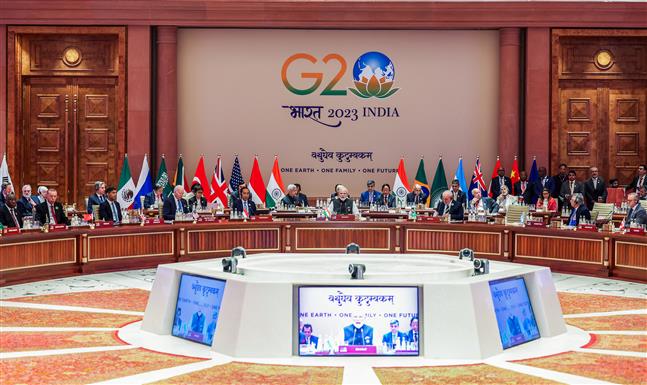G-20 clinches New Delhi Declaration
Context
In an unexpected early breakthrough and win for India’s Presidency, G-20 countries on Saturday welcomed the African Union’s entry into the organization and also agreed on a single statement, forging consensus on the problematic “Ukraine paragraphs”.
What was the consensus statement taken on the Ukraine war in G20?
- A consensus was reached on a common statement regarding the Ukraine war at the G20 summit in New Delhi. The declaration refrained from criticizing Russia for the conflict but urged other nations to refrain from annexing new territory by force. The UN Charter’s need that all states adhere to it was also highlighted in the declaration.
- In comparison to last year, the proclamation used softer wording when discussing Russia’s contribution to the war. For instance, the proclamation eliminated any mentions of Russian invasion and departure. Instead, the proclamation urged all nations to adhere to the UN Charter’s prohibitions on using force and its provisions regarding territorial integrity.
- Additionally, the document noted that the G20 is primarily a forum for economic discussion and is not the appropriate venue for resolving geopolitical concerns and security issues.
- The fact that this declaration seemed to be less critical of Russia than the G-20 statement from Bali the year before represented a change from the positions previously held by the United States, the European Union, and the G-7 nations.
Which countries played a key role in reaching this consensus?
- A proposal put forth by Indonesia, India, Brazil, and South Africa that had been heavily negotiated throughout the summit helped to achieve the breakthrough in consensus.
- The G-7 and EU bloc’s current president, Japan, also contributed to reconciling member nation divides.
Why did the EU and G7 groupings agree to the consensus statement?
- The EU and G-7 nations were given the option of approving the compromise wording or not issuing any statement at all.
- The absence of a declaration would have made it difficult to distinguish from the recent BRICS Summit, where Russia and China had agreed to a joint statement on Ukraine.
- It was believed that maintaining the G-20 platform and organization was essential for global collaboration.
What was the other important decision taken at the summit?
- The African Union’s admission to the G-20 was another noteworthy development at the conference.
- This action was perceived as improving the G-20’s efficacy and giving the global south, notably the African continent, a voice in international fora.
What were the environmental and economic decisions taken in the meeting?
- Eight of the 83 paragraphs in the New Delhi Declaration were devoted to the economic effects of the crisis in Ukraine.
- Agreements linked to bolstering multilateral development banks, regulating cryptocurrencies, and increasing financial inclusion were the outcome of the summit’s finance track.
- The declaration also emphasized the need for considerable investments in clean energy technology and a significant increase in climate financing to reach net-zero emissions by 2050.
Conclusion
Overall, the section explains how India’s G-20 leadership was crucial in reaching an agreement on a unified statement regarding Ukraine and in including the African Union in the G-20. It also emphasizes how crucial it is to keep the G-20 functioning as a forum for international cooperation.





